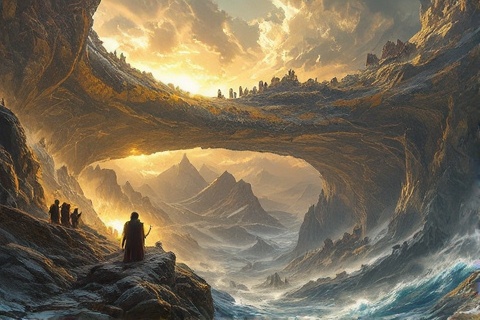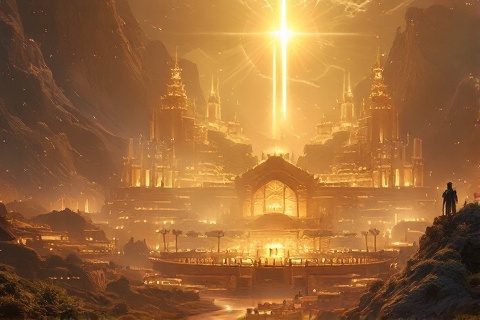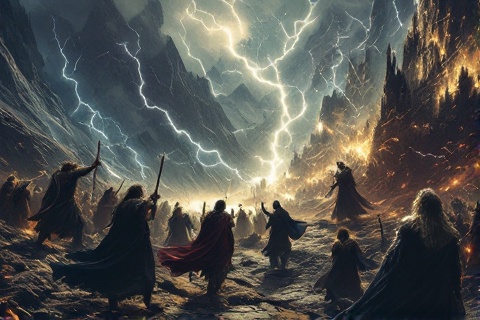
The Valar: Tolkien's Archangels of Middle-earth
Guardians, Makers, and Mystics Beyond the Mortal World
Origins of the Valar: The First Children of Ilúvatar

The Valar came into being through the divine thought of Eru Ilúvatar before Time
itself existed. As the first and most powerful of the Ainur, they embodied the
most profound aspects of Ilúvatar's creative vision, each representing different
facets of his infinite mind and purpose for all of creation.
In the Ainulindalë, the Great Music of creation, the Valar played the most
prominent roles among all the Ainur. Their mighty themes intertwined with one
another, weaving the fundamental patterns of the world that was to come. Each
contributed their own understanding of Ilúvatar's thoughts, creating harmonies
that would later manifest as the physical and spiritual laws of Arda.
After the Great Music, Ilúvatar showed the Ainur a Vision of what their song had
wrought. Many of the most powerful Ainur, who would become known as the Valar,
chose to descend into the newly created world of Arda. They took upon themselves
the responsibility to shape and govern the world according to the themes of the
Great Music, becoming known as the Powers of the World.
The distinction between the Valar and the Maiar lies primarily in
their inherent power and authority. The Valar, often called the Powers of Arda,
possessed greater strength and understanding of Ilúvatar's vision. The Maiar,
while also mighty beings, served as helpers and assistants to the Valar, each
typically associated with a particular Vala whose powers and interests they
shared.
The Powers and Their Domains

Among the Lords of the Valar, each governed fundamental aspects of Arda. Manwë,
King of the Valar and Lord of the Winds, commanded the air and birds,
maintaining a special connection with Ilúvatar's thoughts. Ulmo, never forsaking
the waters of the world, remained closest to the Children of Ilúvatar even in
the darkest times. Aulë, the great craftsman, shaped the substances of Arda and
taught craft to both Elves and Dwarves. Oromë,
the Great Rider, hunted the dark creatures of Melkor and
first discovered the Elves at Cuiviénen.
The Queens of the Valar wielded powers no less mighty than their male
counterparts. Varda, Queen of the Stars and most beloved by the Elves, kindled
the stars and created the great constellations. Yavanna Kementári, the Giver of
Fruits, was responsible for all growing things, from the smallest moss to the
greatest of trees. Nienna dwelt alone, teaching wisdom through patience and
understanding of grief. Estë, the gentle healer, brought rest and recovery to
the weary in her gardens.
The other Valar, though sometimes called lesser, held crucial roles in the
ordering of Arda. Mandos, the stern judge, kept the Houses of the Dead and knew
all fates except those hidden by Ilúvatar. Vairë wove the stories of the world
into her endless tapestries, recording all that transpired in Arda. Irmo, master
of visions and dreams, tended the Gardens of Lórien with his spouse Estë. Vána,
the Ever-young, made flowers bloom by her passing and was closely associated
with the powers of her sister Yavanna.
Each Vala possessed unique abilities that reflected their role in the Music of
the Ainur. Their powers were fundamentally tied to the aspects of Arda they
governed, whether physical elements like water and air, or metaphysical concepts
like death and dreams. While capable of taking physical form, their true power
lay in their ability to shape and influence the fundamental nature of Arda
itself through their will and understanding of the Great Music.
The Shaping of Arda

The Valar's first great works in Arda involved shaping the world according to
the vision they had seen in the Music. They raised mountains, hollowed valleys,
and filled the seas, each contributing according to their nature and power.
Their labors were tremendous, gradually transforming the original symmetry of
Arda into a world of incredible beauty and complexity.
During this period of shaping, Melkor repeatedly destroyed or marred their
works, leading to the First War at the very beginning of time. His discord had
already been present in the Great Music, but now it manifested in physical
destruction. He toppled mountains, opened chasms, and changed the original plan
of Arda, forcing the other Valar to spend much of their strength in repairing
and stabilizing his damage.
Following these early conflicts, the Valar raised the mighty Pelóri Mountains
along the eastern coast of Aman as a protective wall. These mountains, the
highest in all Arda, were created to shield the Blessed Realm from the turmoil
of Middle-earth and Melkor's influence. Behind these
mountains, they established Valinor, their realm of light and
beauty.
The Two Lamps, Illuin in the north and Ormal in the south, were created by Aulë
and hallowed by Varda to illuminate all of Arda. Set upon mighty pillars, they
created an endless day across the world. However, Melkor's assault destroyed
these lamps, causing massive devastation that reshaped the world and forced the
Valar to abandon their original dwelling place of Almaren.
Valinor: The Realm of the Powers

After the destruction of the Two Lamps, the Valar established their new realm in
Aman, the westernmost part of Arda. They poured all their power and artistry
into creating this Blessed Realm, making it the most beautiful place in all of
Arda. The land itself was hallowed, and the light of Aman was different from all
other lights in the world.
Within Valinor, Yavanna sang into being the Two Trees, Telperion the Silver and
Laurelin the Golden. These living lights succeeded the Two Lamps, marking time
with their alternating radiance. Telperion's silver light would wax and wane,
followed by Laurelin's golden glow, creating the first measurement of time in
Valinor.
Each of the Valar established their own domains within Valinor. Manwë and Varda
dwelt upon Taniquetil, the highest mountain of all Arda. Aulë's halls contained
his great forges, while Yavanna's pastures teemed with life. Nienna dwelt in the
far west, while Irmo's gardens of Lórien provided rest for the weary. Mandos'
halls stood in the north, where he received the spirits of the dead.
The Máhanaxar, or Ring of Doom, was established near the gates of Valmar as the
council place of the Valar. Here they would meet to make decisions affecting all
of Arda, discuss matters of import, and deliver judgments. It was in this ring
that many momentous decisions were made, including the fate of the Two Trees and
the doom of the Noldor.
Guardians of the Children of Ilúvatar
When the Valar discovered the awakening of the Elves at Cuiviénen, they
immediately recognized their importance as the Children of Ilúvatar. Oromë first
found them during his travels in Middle-earth, and upon learning of Melkor's
influence over them, the Valar launched the War of the Powers to secure the
safety of the Firstborn.
The Valar extended an invitation to the Elves to dwell in Aman, leading to the
Great Journey westward. They sent Oromë to guide the first Elves, though not all
chose to follow. Those who did undertake the journey were divided into three
groups: the Vanyar, Noldor, and Teleri, each
reaching Aman at different times and in different ways.
In Valinor, the relationship between the Valar and the Eldar flourished. The
Valar acted as teachers and guardians, sharing their knowledge and power with
the Elves. The Vanyar dwelt closest to the Valar, particularly to Manwë and
Varda, while the Noldor learned greatly from Aulë, and the Teleri were taught by
Ossë and Ulmo.
The Valar's relationship with Men was more distant, as they
awakened after the march of the Eldar to Valinor. The Valar chose not to
directly guide Men as they had the Elves, instead providing counsel through the
Eldar and, later, through the Istari. This distance was part of
Ilúvatar's plan, as Men were granted the gift of freedom to shape their own
destiny.
The War of the Powers

During the Years of the Trees, Melkor's presence cast a shadow over the peace of
Valinor. Though he claimed to have repented and was granted limited freedom
within Valinor, he secretly sowed discord among the Noldor, particularly through
his influence on Fëanor. His actions during this time would
have far-reaching consequences for all of Arda.
Following centuries of seeming reformation, Melkor's true nature was revealed
when he was caught trying to corrupt the Noldor. The Valar then bound him with
the chain Angainor, crafted by Aulë, and imprisoned him in the Halls of Mandos
for three ages. During this time, Valinor knew its greatest peace, though the
seeds of discord had already been planted.
The destruction of the Two Trees marked the end of this era of bliss. Melkor,
having gained release from his imprisonment, allied with
Ungoliant, a great spirit of darkness. Together they
destroyed the Trees, plunging Valinor into darkness and stealing the
Silmarils, which contained the last pure light of the
Trees. This act led to the Darkening of Valinor
and profound grief among both the Valar and the Eldar.
When Fëanor and many of the Noldor chose to pursue Melkor to Middle-earth,
defying the Valar and committing the Kinslaying at Alqualondë, Mandos pronounced
the Doom of the Noldor. This prophecy and judgment would shape the fate of the
Noldor throughout the First Age, marking them with tragedy and hardship in their
exile.
The Judgment and Mercy of the Valar
The Valar's role as judges and guides of Ilúvatar's Children was complex and
often challenged by the free will granted to both Elves and Men. They sought to
protect and nurture while allowing both races to make their own choices,
intervening directly only in times of greatest need. Their judgments, while
sometimes appearing harsh, always contained an element of mercy and hope for
redemption.
The Valar demonstrated their mercy most notably in the War of
Wrath, when they finally answered the plea of
Eärendil and moved against Morgoth. They also
blessed the faithful Edain with the gift of
Númenor, raising an island from the sea to serve as their new
homeland. These acts showed their continuing care for the Children of Ilúvatar,
even after previous defiances.
The Ban of the Valar was established to preserve the order of Arda and protect
the mortal races. It forbade the Númenóreans from sailing west toward Valinor,
marking the physical and spiritual boundary between mortal and immortal lands.
This prohibition was not meant as punishment but as a safeguard against the
dangers of mortal ambition exceeding its natural bounds.
Over time, the Valar extended forgiveness to the exiled Noldor, allowing them to
return to the West. This pardon came gradually, with some like
Galadriel being permitted to return only after proving
their wisdom and rejecting the temptations of power. The Valar's forgiveness
demonstrated their understanding of growth and redemption among the Children of
Ilúvatar.
Legacy in Middle-earth

Throughout the history of Middle-earth, the Valar's influence remained constant
though often subtle. Their power and guidance could be seen in the great events
of each age, from the rising of the Sun and Moon to the final battles against
darkness. While they chose not to intervene directly in most conflicts, their
influence helped maintain the balance of power in Arda.
The sending of the Istari in the Third Age represented one of
the Valar's most direct interventions in the affairs of Middle-earth after the
War of Wrath. These five wizards, Maiar spirits clothed in the bodies of old
men, were tasked with guiding and counseling the free peoples in their fight
against Sauron, though forbidden from dominating them or
matching power with power.
According to the prophecies recorded in the Halls of Mandos, Morgoth will
eventually return for a final battle, the Dagor Dagorath. In this Last Battle,
it is said that Túrin Turambar will deliver the
death blow to Morgoth, the world will be remade, and the themes of Ilúvatar's
Music will be played correctly at last.
By the Third Age, the Valar's presence in Middle-earth had become largely
indirect, felt primarily through natural forces and rare interventions. The age
of direct communion between the Valar and the Children of Ilúvatar had passed
into legend, though they continued to guide and protect from afar, maintaining
their vigil over Arda until the end of days.
